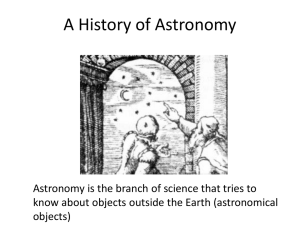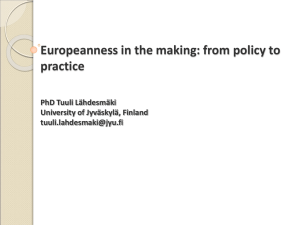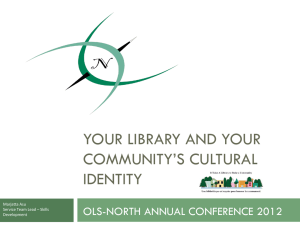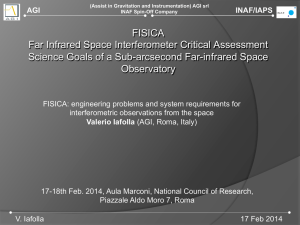The AstroBID : preserving and sharing the Italian
advertisement
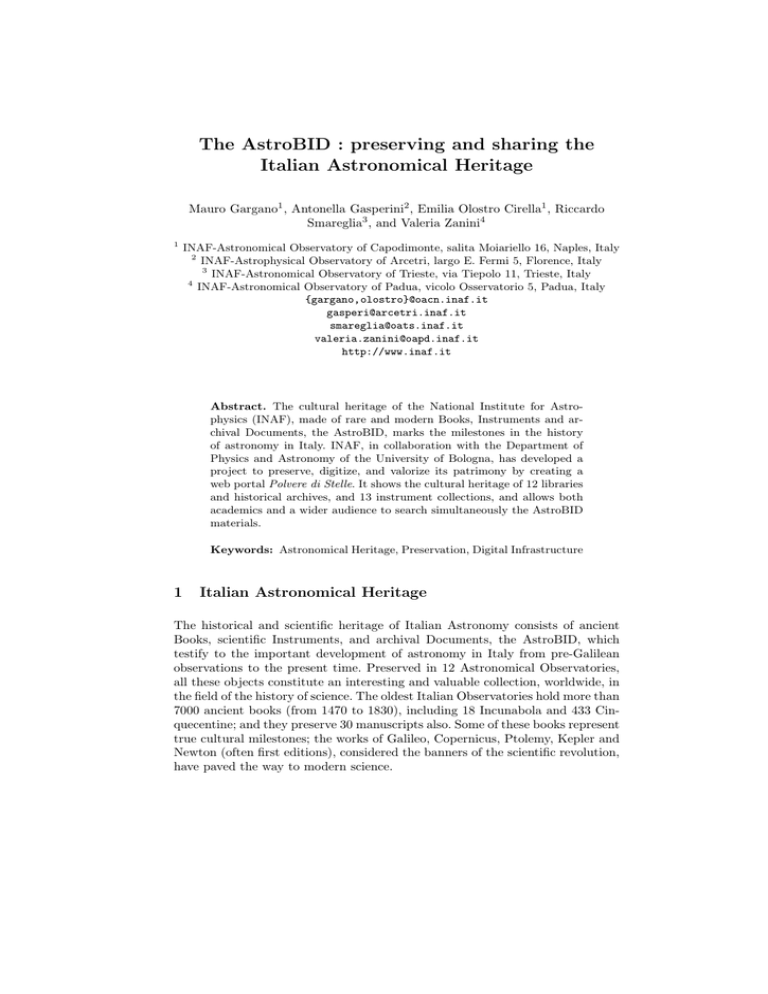
The AstroBID : preserving and sharing the
Italian Astronomical Heritage
Mauro Gargano1 , Antonella Gasperini2 , Emilia Olostro Cirella1 , Riccardo
Smareglia3 , and Valeria Zanini4
1
INAF-Astronomical Observatory of Capodimonte, salita Moiariello 16, Naples, Italy
2
INAF-Astrophysical Observatory of Arcetri, largo E. Fermi 5, Florence, Italy
3
INAF-Astronomical Observatory of Trieste, via Tiepolo 11, Trieste, Italy
4
INAF-Astronomical Observatory of Padua, vicolo Osservatorio 5, Padua, Italy
{gargano,olostro}@oacn.inaf.it
gasperi@arcetri.inaf.it
smareglia@oats.inaf.it
valeria.zanini@oapd.inaf.it
http://www.inaf.it
Abstract. The cultural heritage of the National Institute for Astrophysics (INAF), made of rare and modern Books, Instruments and archival Documents, the AstroBID, marks the milestones in the history
of astronomy in Italy. INAF, in collaboration with the Department of
Physics and Astronomy of the University of Bologna, has developed a
project to preserve, digitize, and valorize its patrimony by creating a
web portal Polvere di Stelle. It shows the cultural heritage of 12 libraries
and historical archives, and 13 instrument collections, and allows both
academics and a wider audience to search simultaneously the AstroBID
materials.
Keywords: Astronomical Heritage, Preservation, Digital Infrastructure
1
Italian Astronomical Heritage
The historical and scientific heritage of Italian Astronomy consists of ancient
Books, scientific Instruments, and archival Documents, the AstroBID, which
testify to the important development of astronomy in Italy from pre-Galilean
observations to the present time. Preserved in 12 Astronomical Observatories,
all these objects constitute an interesting and valuable collection, worldwide, in
the field of the history of science. The oldest Italian Observatories hold more than
7000 ancient books (from 1470 to 1830), including 18 Incunabola and 433 Cinquecentine; and they preserve 30 manuscripts also. Some of these books represent
true cultural milestones; the works of Galileo, Copernicus, Ptolemy, Kepler and
Newton (often first editions), considered the banners of the scientific revolution,
have paved the way to modern science.
2
M. Gargano, et al.
Besides the value due to the content
contributing to the history of western culture, these books are also interesting for their fine and precious
illustrations. The marvellous star atlases of Hevelius, Doppelmayer, Flamsteed and Bode, the cometographies
and selenographies of Northern European astronomers, published in the
16th and 17th centuries, reveal a host
of details, illustrated with painstaking care in works of rare beauty that
merged art, mythology and science
[4]. The oldest document of the National Institute of Astrophysics is a
manuscript preserved in the Library
of the Copernican Museum in Rome,
that dates back to the end of 1300
(Fig. 1). It is a collection of medieval Fig. 1. Theorica planetarum by Johannes
astronomical texts, probably the most de Sacrobosco (xiv century). A page from
the most ancient manuscript owned by
popular essays of that period.
The ancient astronomical instruments INAF.
collection of the Italian Observatories is over 1200 items, from the XI
century (Fig. 2) to the first half of
the 1900. Exhibited in 13 museums,
it consists mainly of quadrants, sextants, telescopes, theodolites, clocks,
stopwatches, globes, mathematical instruments, and meteorological instrumentations [2]. Among the most precious instruments, the museum collections preserve some arabic astrolabes, one of the biggest mirror for
a telescope made by William Herschel, the telescope used by Schiaparelli to describe the surface of Mars
and hypothesize a planet inhabited by
Martians, and the instruments manufactured and used by Italian as- Fig. 2. The Arabic astrolabe made by Ibn
tronomers to realize a ”new science”, Sahid el Ibrahim, Valencia, 1096.
astrophysics.
The historical archives of the astronomical observatories preserve the documents
of some of the oldest scientific institutions in our country: records from countless
nights spent at the telescope, beautiful sketches of nebulae, comets and planets,
The AstroBID : preserving and sharing the Italian Astronomical Heritage
3
drawn during the observations under an astronomical dome, letters revealing
the stream of cognizance to some extraordinary scientific discoveries, journey
logbooks, meteorological observations as a continuum line throughout the centuries, settled bills, read books, reports from journeys, maps, sketches.
Over 3 million documents, 122 series containing the fonds of various astronomers
are preserved in 12 historical archives [3].
2
Polvere di Stelle: the web portal
In order to present and share the AstroBID to the largest number of people,
ranging from scientists and historians to amateur astronomers and general public, INAF has realized Polvere di Stelle (Stardust)1 (Fig. 3), the web portal of
the Italian astronomical cultural heritage.
Polvere di Stelle presents the modern and ancient library catalogs, the archival
inventories, and the museum collections of the Italian Astronomical Observatories and also the astronomical heritage of the Department of Physics and Astronomy of the Bologna University. Besides the historical descriptions for all types of
materials, Polvere di Stelle allows for simultaneous searches on books, archives,
museums, and astronomer’s biographies databases, establishing useful interconnections to build particular events and aspects of the history of astronomy.
The AstroBID materials
are recorded in different
databases following the international standards and
the ICCU recommendations for cataloguing modern and ancient books, and
manuscripts, for the inventorying of the archive documents, for the description
of scientific instruments,
artworks, and biographies
of astronomers and craftmakers. In addition there
are two indexes for authors
and bibliographies [5].
The portal permits the
Fig. 3. The home page of Polvere di Stelle available at performance of interlinking searches among the
www.beniculturali.inaf.it
AstroBID records with simultaneous queries on different databases to build thematic pathways of important astronomical events, discoveries, biographies of astronomers, and the use of
astronomical instruments.
1
www.beniculturali.inaf.it
4
M. Gargano, et al.
A digital showcase plays a relevant role in Polvere di Stelle. Using the knowhow for storing and sharing the astronomical data, the Italian data-center for
Astronomical Archives, IA2, hosted by the Astronomical Observatory of Trieste,
has set up a high availability platform to create a national repository for the
digitalized copy of the ancient books. IA2 is a national infrastructure project to
implement ”a new strategy for preserving and providing access to the astrophysical data heritage”. IA2’s informatics infrastructure is based on the virtualization
and cloud paradigm, hosts data from the main ground based Italian Telescopes
and offers proprietary and public data access through user portals and Virtual
Observatory (VO) services. All software tools are based on Open Source application and developed in C++, Java and PHP. To best manage all metadata and
services information, stored inside, the DMBS plays a main role. Using this infrastructure, and in particular a data cloud storage, we have stored over 100000
pages of about 250 ancient books related to the scientific heritage in the different
resolutions: images at 150 DPI are used to publish the books on the web with
a watermark on each page, and 300 and 600 DPI images are used to preserve
a digital copy of each book and to use them in historical and scientific studies.
Hyper resolution images will be also saved as FITS (Flexible Images Transport
System). This format is widely used within the astronomical community since
1981. It was developed to ensure long-term preservation of data and documents.
In addition to storing images, a FITS file may contain many other additional
information inside its keyword header. It is free from legal restrictions and is
kept updated by IAU (International Astronomical Union). INAF and Vatican
Apostolic Library are working together to extend the FITS keywords dictionary
for the needs of cultural heritage data preservation [1].
At present, the digital showcase allows one to consult a little part of the ancient
book heritage in a colour digital format and in very good resolution. People can
leaf through some terrific volumes like the Tractatus de Sphaera by J. Holywood (end of XIV century), and the De Revolutionibus Orbium Coelestium by
N. Copernicus (1543).
References
1. Allegrezza, S.: Analisi del formato FITS per la conservazione a lungo termine dei
manoscritti. Il caso significativo del progetto della Biblioteca Apostolica Vaticana.
In: Digitalia, A. VI, n. 2 (2011), pp. 43–72
2. Chinnici, I. (ed.): Astrum 2009: astronomy and instruments. Sillabe, Livorno (2009)
3. Gargano, M., Gasperini, A., Mandrino, A.: Polvere di stelle - Stardust: The national
historical archive for astronomy on the web. In: Library and Information Services
in Astronomy VI: 21st century astronomy librarianship, from new ideas to action,
pp. 244–247, ASP, San Francisco (2010)
4. Olostro Cirella, E, Caprio, G.: Le Cinquecentine dell’Osservatorio Astronomico di
Capodimonte”. Giannini, Napoli (2014)
5. Olostro Cirella, E, et al.: The AstroBID: searching through the Italian astronomical
heritage. In: Library and Information Services in Astronomy VII: Open science at
the frontiers of librarianship, pp. 143–149, ASP, San Francisco (2014)
